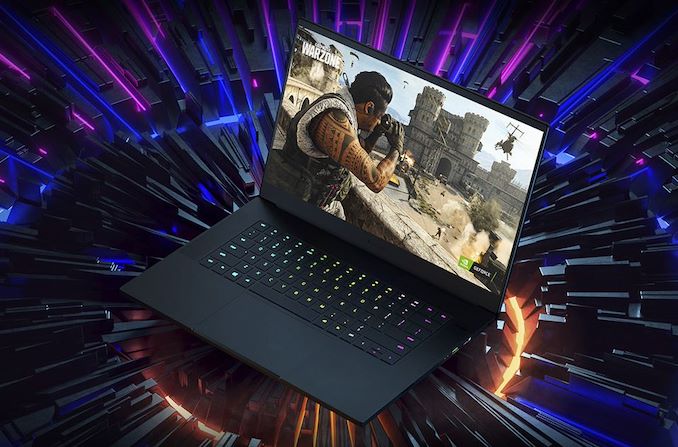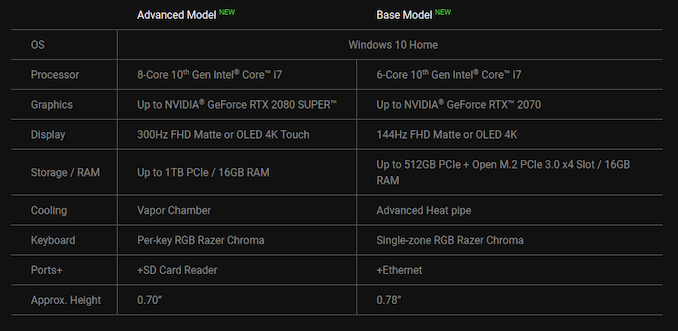Razer Refreshes Blade 15 Series With Intel 10th Gen Comet Lake
by Gavin Bonshor on April 3, 2020 11:00 AM EST- Posted in
- Laptops
- Intel
- Optimus
- Razer
- NVIDIA
- RTX
- Comet Lake
- Razer Edge 15

Along with many other OEMs in the notebook segment at the moment, Razer has joined in the fray with the launch of two new models of its Blade 15 series of gaming notebooks. Building upon Intel's newly announced 10th generation Comet Lake-H processors, both models also include options for using NVIDIA's new RTX Super mobile GPUs.
Starting off with the new flagship Blade 15 Advanced model, Razer claims it to be the world's smallest laptop with with a 15.6" screen, with a weight of just 2.2 Kg. Included in the Advanced model is the new Intel Core i7-10875H eight-core Comet Lake-H processor, with a max turbo of up 5.1 GHz and a base clock of 2.3 GHz. Some of the core features include Intel Thunderbolt 3 Type-C and a USB 3.1 G2 Type-C port supporting USB-C 20 V PD 3.0 charging capabilities. Powering the laptop is a built-in 80 Wh rechargeable lithium-ion polymer battery, with a compact 230 W power adapter which is supplied with both models.
The advanced model is available with a choice between a 300 Hz HD TFT LCD for hardcore gamers, and a more creator-focused OLED 100% DCI-P3 4K touch panel with a 1 ms response time. Powering the display are NVIDIA's current lineup of notebook GPUs, with the top option being the GeForce RTX 2080 Super with 8 GB of GDDR6 memory. As for storage, Razer has equipped the Blade 15 with a PCIe 3.0 NVMe SSDs, with capacities up to 1 TB. Keeping the components cool in the advanced model is a vapor chamber design, while the base model uses a standard heat pipe design.
Meanwhile the base model comes equipped with the six-core Intel Core i7-10750H processor, while the GPU choice goes up NVIDIA GeForce RTX 2070, also using Optimus. Also available with two display types, the base model can come with either a 144 Hz Full HD display with a matte screen or with an OLED 100% DCI-P3 panel. Providing power is a slightly lower spec 65 Wh polymer battery, with Intel Thunderbolt 3 Type-C, an HDMI 2.0B video output, and dual USB 3.1 G1 Type-A ports.

The specifications of the new Razer Blade 15 2020 Models
Both models come finished with a black frame with a backlit green Razer logo and are equipped with 16 GB of dual-channel DDR4-2933 memory, benefit from an Intel AX201 Wi-Fi 6 adapter with BT 5.0 support, and include a precision glass touchpad.
Neither variants of the Razer Blade 15 are cheap, with the Basic starting at $1,600, while the Advanced model begins at $2,600. Both models look set to be available in retail channels in May.
Related Reading
- NVIDIA's 2020 Laptop Refresh: Launches GeForce RTX 2080 Super, 2070 Super, & GTX 1650 Ti
- Intel Details 10th Gen Comet Lake-H for 45 Notebooks: Up to 5.3 GHz*
- NVIDIA Details Dynamic Boost Tech & Advanced Optimus (G-Sync & Optimus At Last
- MSI Launches New 10th Gen Core Laptops With NVIDIA RTX Super And Mini LED
Source: Razer











17 Comments
View All Comments
willis936 - Friday, April 3, 2020 - link
No word on OLED refresh rate, so we're to assume 60 Hz? What's the hold up here? Every person who uses a monitor wants a high refresh rate OLED, so there is a market for it. It's not like there are technical limitations in the display technology, and it's not like there is a limit anywhere else in the chain for high pixel clocks (literally a 300 Hz LCD is a drop-in replacement). So why are they shipping with 60 Hz? To save cost? OLED is a premium option. It can't add a significant percentage of cost.Unashamed_unoriginal_username_x86 - Friday, April 3, 2020 - link
Display brightness suffers at high refresh rates, and OLED isn't known for its great brightness.You're also underestimating the effect it would have on battery, as with typical screen usage OLED is pretty tough on that too.
It's also targeted towards media content creation, which essentially never goes beyond 60Hz. It wouldn't be amortised cost. See: photography, movies, animation & drawing...
PeachNCream - Friday, April 3, 2020 - link
Given that the laptops are running a 2070 or 2080, it seems like battery life is something that has been placed in second row seating behind graphics performance. I doubt that the target audience will care about a further loss of battery life from a high refresh screen. Razer customers are a bit like Apple customers in that they care a lot more about d!ck waving over practical usage.Retycint - Saturday, April 4, 2020 - link
You know Optimus is a thing, right? It doesn't matter, in terms of power consumption, whether the GPU is a MX350 or an RTX2080 if it's switched off.PeachNCream - Sunday, April 5, 2020 - link
Yup and it's one of the most useful features to come out of dGPUs in laptops in ages. You buy a laptop with a dGPU and ideally a shared cooling system between the graphics chip and the CPU then force everything to stay on the iGPU. Cooling fans don't have to work as hard and the system stays a lot quieter and cooler. Its even better if you set everything to max battery in power settings and choke the CPU clockspeed to somewhere around 80% even when plugged in. It still doesn't beat some of the really low TDP fanless laptops out there when it comes to usefully quiet operation, but that can help to an extent with fan noise.SSTANIC - Friday, April 3, 2020 - link
+1edzieba - Monday, April 6, 2020 - link
"It's not like there are technical limitations in the display technology"Gotta laugh at people ignoring the last 6 years of VR display development, where 'black smear' (AKA OLED low level activation lag) has been a long-standing issue. One that everyone has solved by... switching to fast-switch LCDs.
OLEDs can switch on and off very fast in ideal scenarios (e.g. bang-bang operation for PWM), but the devil is in the details when you want to make a sample-and-hold display out of them. Same as you can get 50μs switch time LCD panels in welding helmets, but the switch time for an LCD cell in a monitor is nowhere near that.
linamking9 - Thursday, April 16, 2020 - link
Make 6150 bucks every month... Start doing online computer-based work through our website. I have been working from home for 4 years now and I love it. I don't have a boss standing over my shoulder and I make my own hours. The tips below are very informative and anyone currently working from home or planning to in the future could use this website…... https://2.gp/a71FfPeachNCream - Friday, April 3, 2020 - link
I really like how forward looking Razer is being with the base model. Giving up to 512GB of storage should allow me to install at least 2 contemporary games and though I may have to uninstall them, I expect fully to be able to keep at least one next gen console port on it by around this time next year.neo_1221 - Friday, April 3, 2020 - link
512GB + an open M.2 slot.